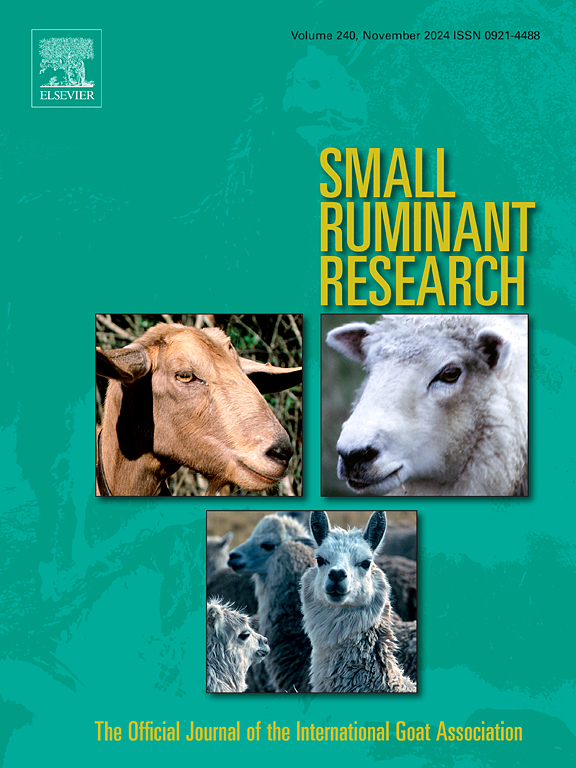南印度本地黑山羊品种可追溯性的发展
IF 1.6
3区 农林科学
Q2 AGRICULTURE, DAIRY & ANIMAL SCIENCE
引用次数: 0
摘要
阿塔帕迪黑山羊是印度喀拉拉邦阿塔帕迪山脉部落社区饲养的一种肉类品种,在该地区的经济中发挥着关键作用,为社会弱势群体的生计做出了重大贡献。本研究旨在建立和验证一套品种特异性遗传标记,以实现Attappady黑山羊和Malabari山羊的精确区分。采用确定性方法,利用品种特异性标记建立阿塔帕迪黑山羊品种遗传溯源。利用Illumina goat SNP50 BeadChip基因分型获得的参考山羊群体(Attappady Black和Malabari各24只)的高通量全基因组SNP基因分型数据,鉴定候选品种特异性标记。从参考群体中鉴定的605个Attappady品种推定标记中,选择9个Attappady品种推定标记,将其转化为聚合酶链反应-限制性片段长度多态性(PCR-RFLP)标记,并在447只山羊(246只Attappady Black和201只Malabari)的大样本山羊群体中进行基因分型,验证其品种特异性。经验证,4个标记均保持品种特异性,鉴定概率(Pi)在0.24 ~ 0.66之间。4个Attappady Black品种特异性标记组的Pi为0.92,误判概率(Pm)为0.04。这些品种特异性标记具有促进品种可追溯性的巨大潜力,从而确保它们得到保护,并提高依赖它们的部落社区的社会经济地位。今后的研究应侧重于这些标记在常规品种鉴定和利基畜产品营销中的更广泛应用。本文章由计算机程序翻译,如有差异,请以英文原文为准。
Development of breed traceability for autochthonous attappady black goats of South India
Attappady Black goats, a meat-type breed raised by the tribal communities of the Attappady hill ranges in Kerala, India, play a pivotal role in the region’s economy, heavily contributing to the livelihoods of its socially disadvantaged population. This study aimed to develop and validate a set of breed-specific genetic markers to enable the precise differentiation of Attappady Black goats from Malabari goats. Breed genetic traceability for Attappady Black goats was developed by adopting deterministic approach using breed specific markers. High throughput genome-wide SNP genotypic data of reference goat population (24 each from Attappady Black and Malabari) obtained by Illumina Goat SNP50 BeadChip genotyping was used to identify candidate breed specific markers. Among the 605 numbers of putative Attappady breed specific markers identified in the reference population, nine putative Attappady breed specific markers were selected and were validated for breed specificity by converting them into polymerase chain reaction -restriction fragment length polymorphism (PCR-RFLP) markers and genotyped in large sample goat population of 447 goats (246 Attappady Black and 201 Malabari). On validation, four markers retained their breed specificity with probability of identification (Pi) ranging from 0.24 to 0.66. Panel of four Attappady Black breed specific markers yielded Pi of 0.92 with a probability of misjudgement (Pm) of 0.04. These breed-specific markers hold significant potential for facilitating breed traceability thus ensuring their conservation and enhancing the socioeconomic status of the tribal communities that rely on them. Future research should focus on the broader application of these markers in routine breed authentication and in marketing niche livestock products.
求助全文
通过发布文献求助,成功后即可免费获取论文全文。
去求助
来源期刊

Small Ruminant Research
农林科学-奶制品与动物科学
CiteScore
3.10
自引率
11.10%
发文量
210
审稿时长
12.5 weeks
期刊介绍:
Small Ruminant Research publishes original, basic and applied research articles, technical notes, and review articles on research relating to goats, sheep, deer, the New World camelids llama, alpaca, vicuna and guanaco, and the Old World camels.
Topics covered include nutrition, physiology, anatomy, genetics, microbiology, ethology, product technology, socio-economics, management, sustainability and environment, veterinary medicine and husbandry engineering.
 求助内容:
求助内容: 应助结果提醒方式:
应助结果提醒方式:


